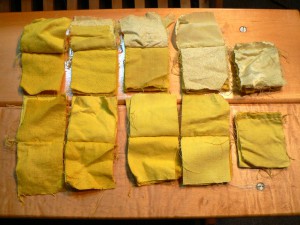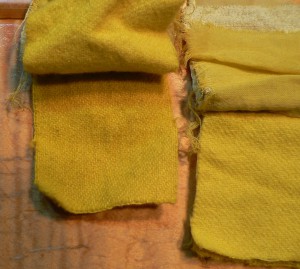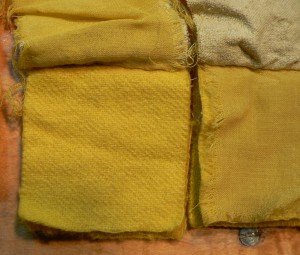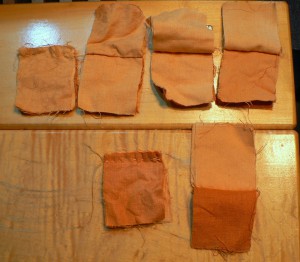On March 8th I presented two workshops at the annual conference of Massachusetts Agriculture in the Classroom. You can check out their website here. One workshop was on growing and processing flax, and on ways to incorporate flax into the school curriculum. The other was on growing a dye plant garden at school and using dye plants with kids.
Based on an idea from Joan Morris, shibori artist extraordinaire, I decided to make two swatch books for the dyeing workshop. Each book had five small cloth samples sewn together. The dimensions were 3 inches by 1.5 inches. One swatch book was made up of cellulose (i.e., plant-based) cloth samples, including three kinds of cotton cloth, a linen-rayon blend, and a 100% linen piece. The other was made of protein (animal-derived) cloth, including silk satin, raw silk, and three weights of wool. I mordanted the cellulose swatch books with aluminum acetate at 5% WOG (weight of the goods, or fiber). I mordanted the protein swatch books with aluminum sulfate, at 1 tablespoon per 4 ounces. The protein booklets weighed about 6oz. altogether, and interestingly the cellulose booklets weighed almost the same.
For the workshop, I wanted to give participants samples from two different dyeplants. I decided on weld (Reseda luteola, a biennial) and orange cosmos (Cosmos sulphureus varietals, all annuals). Both are excellent for attracting pollinators. So, half of the protein books (~3 oz.) and half of the cellulose books (~3oz) would be dyed with each plant material. The total WOG for each plant material was thus ~6 oz.
In preparation for the workshop, I made a strong dyebath of weld from the dried tops of second year plants in bloom. Weld is an excellent source of yellow, and is beautifully enhanced with a high pH and with calcium carbonate in the dyebath. I used 6 ounces of dried plant material for 6 ounces of fiber (i.e., half of the protein booklets and half of the cellulose booklets), and I dyed both protein and cellulose swatch books for all the workshop participants ahead of time. Because cellulose fibers and protein fibers require slightly different treatment, I divided the weld dyebath into two pots. I added calcium carbonate at 3% WOG to the cellulose dyebath, which dramatically heightened the color. I did not add anything to the protein dyebath, so it was rather drab in contrast. Then, in the workshop we used an afterbath to adjust the color of the protein swatch books. We submerged them in a soda ash solution of approximately pH 10 and the color brightened significantly.
Here are the photos of the weld samples after a delayed rinse (drying before washing), washing, and drying again:
Above you can see the protein (top row) and the cellulose (bottom row) swatch books. From left to right on the top row: natural wool from Wool and Dye Works in Florence, MA; bleached wool from Wool and Dye Works; wool gauze from Delectable Mountain in Brattleboro, VT; raw silk (old stash, I think from my sister Simone), and silk satin (Dharma Trading–I cut up a scarf). From left to right on the bottom row: 100% linen; linen-rayon blend (both from Dharma); heavy-weight cotton; mid-weight cotton; and cotton damask (all from the Textile Company in Greenfield, who do not have a website). (12/26/2023 Edited: Delectable Mountain in Brattleboro, VT has sadly closed. Here’s a link to their old website thanks to the Wayback Machine.
Below you can see a closer view of the cellulose swatch books, with the linen and linen-rayon blends on top and cottons on the bottom row. Personally I think weld has a special affinity for linen to the point that it creates an almost neon vibrancy, though the linen-rayon blend was also spectacular.
Below is a closer view of the protein swatch books. Silks are on the top and wools are on the bottom. The silks were dull and kind of gray compared to the wools. I would not recommend weld on silk for maximum effect, though there may be some tricks to silk that I’m not savvy about.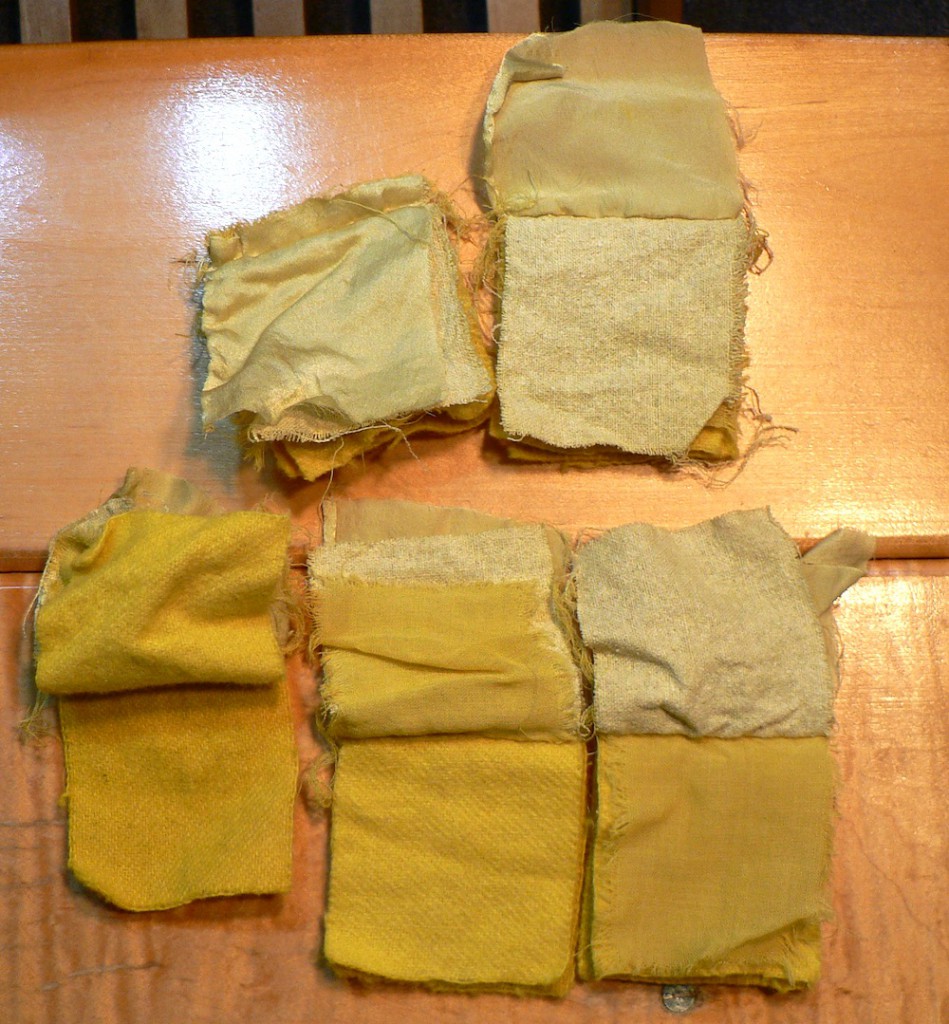
The weld on natural (unbleached) wool was very rich (on the left below):
On the bleached wool it was glowing (sample on the left below):
The slightly frayed sample on the right is the wool gauze (from Italy!). It is very fine and sheer, so there is not a lot of density to suck up and reflect the color. Nevertheless, it is intense and lovely.
I also made a dyebath with frozen orange cosmos ahead of time. I used 12 ounces of frozen flowers for 6 ounces of fiber. The workshop was pretty short (an hour and ten minutes) which is too short for the time-frame of a decent dyebath, in my opinion. Nevertheless, I wanted participants to see at least some of the steps of the dyeing process and I wanted the color to be impressive. Normally, you can use a much lower ratio of plant material to fiber for orange cosmos. At the beginning of the workshop I showed folks how to strain out the plant material from the steeped dyebath, and we put the remaining swatch books into the dyebath, along with a glug of soda ash solution. Orange cosmos are also pH sensitive, and a high pH shifts the color to a rich red-orange. Unfortunately the participants’ samples didn’t get to heat and steep as long as I would have liked, but they were still pretty nice!
Luckily, I got to take home the dyebaths and I re-heated the extra swatch books in the orange cosmos bath, then allowed them to soak overnight. Below are the cellulose books:
Top row left to right: Cotton damask, thick cotton, mid-weight cotton (two, because at the time I thought they looked like different colors), and thin cotton. Bottom row left to right: 100% linen, linen-rayon blend.
Below are the protein swatch books:
The top row are the silks (satin on the left, raw on the right). Bottom row left to right: natural wool, bleached wool, wool gauze.
I feel very pleased with these little booklets. I hope the workshop participants enjoyed the experience and came away with useful information.
Next up, exhausting the dyebaths….

